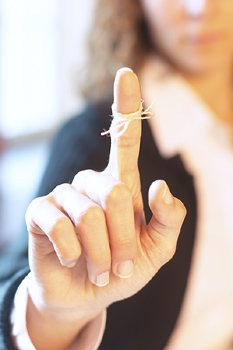How to Never Forget Anything Again
(from mercola.com)
 The human brain is a wonderful thing, but it’s a bit faulty as a tool for remembering things. But with the proper habits and the right tools, you and your brain won’t have to remember a thing again. There are a host of high-tech tools that can help with taking notes, managing projects and to-dos, and managing your email and calendar needs.
The human brain is a wonderful thing, but it’s a bit faulty as a tool for remembering things. But with the proper habits and the right tools, you and your brain won’t have to remember a thing again. There are a host of high-tech tools that can help with taking notes, managing projects and to-dos, and managing your email and calendar needs.
To really never have to remember a thing again, you have to combine a few tools in smart and comprehensive fashion, and even more importantly, you have to develop specific habits that will ensure that things don’t slip between the cracks.
A Comprehensive System
A comprehensive system will handle many types of data, from phone numbers and emails to tasks and projects, from follow-ups to status reports, and from errands and appointments to websites and photos. One such set-up might include Evernote, Gmail, Gcal, Anxiety and Jott:
- Evernote: This is a great app for storing just about any information you want. In fact, if you wanted to simplify your setup, you could almost just use Evernote to remember everything. It can hold notes, clip web pages, store photos and audio notes, and more.
- Gmail: Gmail uses archive and search (along with labels if you like) to quickly store and retrieve any information you need.
- Gcal: Also known as Google Calendar, Gcal is accessible from anywhere. Need to remember to follow up on something? Set a reminder in Gcal for one week from now, and it will send you a message.
- Anxiety: Anxiety is a to-do app. It’s very lightweight and very simple.
- Jott: This handy app ties everything together, and is very valuable for when you’re on the go. Just call Jott from your cell phone and leave a message, and it’ll be sent to your email, or to another service you specify.
4 Critical Habits
If you want such a system to work, you’ve also got to develop the habits to make it work. Focus on developing these habits for one month. If you can do that, the habits should stick.
- Make a note, immediately. This is perhaps the most important habit. If you can teach yourself to make a note of things right away, immediately, without putting it off, you’re halfway there.
- Use your lists and tools, consistently. No program is worth anything if you don’t use it on a consistent basis.
- Make it quick and painless. If it’s difficult to add a note or save information, you’ll put it off. You want it fast and easy, or it won’t work.
- Archive and search, don’t file. It’s better to use a quick search function than to have to remember where you saved something.
ALTERNATIVE TOOLS AND SETUPS
Here are some other good apps:
Note-taking Tools
1. OneNote: This is the default note-taking tool for anyone who uses Microsoft Office, and it’s very powerful.
2. Yojimbo: A Mac-only program, Yojimbo is beloved by its many users for its power, flexibility, and easy of use.
3. Backpack and Packrat: One of the best of many web apps for collecting info, Backpack is versatile and easy to use. For Mac OSX users, there’s also a desktop application, Packrat, that works well with Backpack for off-line needs.
Email Apps
1. Mail.app: Mail.app comes with Macs and that has some very powerful filters for manipulating emails and to-do items.
2. Outlook: Outlook is the default mail program for PCs, and it’s actually a pretty good program for capturing most of your data, including calendar and to-do items.
Calendars
1. iCal: Free, simple calendar program for Mac users.
2. 30 Boxes: Good online program.
3. Sunbird: Open-source, cross-platform calendar app from Mozilla, the creator of Firefox.
To-do Apps
1. Things: A Getting Things Done app for the Mac. Simple and easy to use.
2. Omnifocus: Another GTD program for the Mac, maybe the most powerful there is.
3. iGTD: Yet another great GTD program for the Mac.
4. RTM: Remember the Milk is probably the most popular online to-do app, and it’s extremely flexible– you can integrate it with Gmail, Twitter, Jott, text messages, email and more.
On-the-go Tools
1. Mobile devices: the iPhone, Blackberry and various PDAs are all good choices for capturing tasks and information on the go.
2. Pocket notebook: You can also use a small notebook (or index cards) for capturing data, and enter the data into your computer when you get home.
Sources:
|
Make a Smart and Simple Move to Good Health… Stop gambling with your health and make the smart move to a high quality, raw food multi. Dr. Mercola’s Whole Food Multivitamin is:
Don’t put off your good health even one more minute. |
| Find Out More |
Related Articles:


